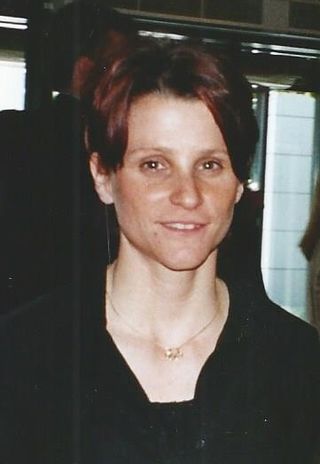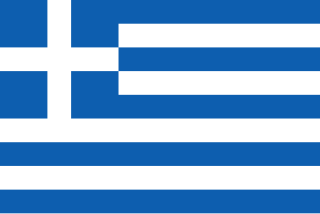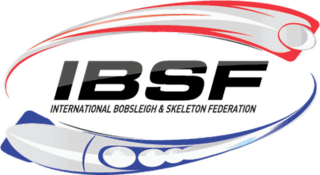
Bobsleigh or bobsled is a winter sport in which teams of 2 to 4 athletes make timed runs down narrow, twisting, banked, iced tracks in a gravity-powered sleigh. International bobsleigh competitions are governed by the International Bobsleigh and Skeleton Federation.

Skeleton returned to the program of the Winter Olympic Games for the first time in 54 years at the 2002 Games in Salt Lake City, Utah. This was the first time Olympic competitions in skeleton were held during an Olympics outside of St. Moritz. Both men and women competed, with women competing for the first time in Olympic history. Medals were awarded after five runs down the course. Both events were contested on February 20.

Tristan Gale is an American skeleton racer who competed from 2001 to 2006. At the 2002 Winter Olympics, she became the inaugural women's skeleton champion. Gale dyed her hair with streaks of red, white and blue for the 2002 Olympics. During the 2002–2003 season, Tristan won a second gold medal on her home track in Salt Lake during a World Cup stop. She remains undefeated at the track in Utah since the Olympics.

Skeleton is a winter sliding sport in which a person rides a small sled, known as a skeleton bobsled, down a frozen track while lying face down and head-first. The sport and the sled may have been named from the bony appearance of the sled.

Sledding, sledging or sleighing is a winter sport typically carried out in a prone or seated position on a vehicle generically known as a sled, a sledge (British), or a sleigh. It is the basis of three Olympic sports: luge, skeleton and bobsledding. When practised on sand, it is known as a form of sandboarding. In Russia sledges are used for maritime activities including fishing and commuting from island to island on ice.

Maya Pedersen-Bieri is a Swiss-Norwegian skeleton racer who has competed since 1995. She won the gold medal in the women's skeleton event at the 2006 Winter Olympics in Turin. She retired from the sport in 2010 before returning to compete for Norway in 2016, becoming at the oldest woman to start a World Cup race when she returned to the top level of skeleton in 2017. She is listed in the International Bobsleigh and Skeleton Federation athlete registration system as Maya Pedersen.

Mellisa Hollingsworth is a retired Canadian athlete who competed from 1995 to 2014. She won the bronze medal in the women's skeleton event at the 2006 Winter Olympics in Turin.
Alexandra Andrea Coomber is a British skeleton racer who competed in the late 1990s and early 2000s. She won the bronze medal in the women's skeleton event at the 2002 Winter Olympics in Salt Lake City, while competing with a broken wrist, having broken it in training 10 days prior to her race.
Gerda Weissensteiner OMRI is an Italian luger and bobsleigh pilot who competed from the late 1980s to 2006. Competing in six Winter Olympics, she won the gold medal in the women's singles luge event at the 1994 Winter Olympics in Lillehammer, and together with Jennifer Isacco she won the bronze in Turin in the two-woman bobsleigh at the 2006 Winter Olympics. She was the first Italian sportsperson to win Olympic medals in two disciplines.

Skeleton is a winter sport featured in the Winter Olympics where the competitor rides head-first and prone on a flat sled. It is normally run on an ice track that allows the sled to gain speed by gravity. It was first contested at the 1928 Winter Olympics in St. Moritz and again in 1948 Winter Olympics, after which it was discontinued as an Olympic sport.

Silke Kraushaar-Pielach is a German luger who competed from 1995 to 2008. In June 2008, she was named sports manager for the luge section of Bob- und Schlittenverband für Deutschland.

Greece competed at the 2002 Winter Olympics in Salt Lake City, United States. Cindy Ninos finished 13th in the women's skeleton event, which is the best result for Greece at the history of the Winter Olympic Games.

Noelle Pikus-Pace is an American retired skeleton racer who began her career in 2001. She won five medals at the FIBT World Championships, competed in the 2010 Winter Olympics in Vancouver, and won the silver medal in the 2014 Winter Olympics in Sochi.

The International Bobsleigh and Skeleton Federation (IBSF) is the international sports federation for the sliding sports of Bobsleigh and Skeleton. It was founded on 23 November 1923 by the delegates of Great Britain, France, Switzerland, Canada, and the United States at the meeting of their first International Congress in Paris, France. In June 2015, it announced a name change from FIBT to IBSF. The federation's headquarters are in Lausanne, Switzerland.
The IBSF World Championships, part of the International Bobsleigh and Skeleton Federation, have taken place on an annual basis since 1930. Starting with 2002, no World Championships being held in non-Winter Olympic years. A two-man event was included in 1931 with a combined championship occurring in 1947. Men's skeleton was introduced as a championship of its own in 1982 while women's bobsleigh and skeleton events were introduced in 2000. Both the women's bobsleigh and skeleton events were merged with the men's bobsleigh events at the 2004 championships. A mixed team event, consisting of one run each of men's skeleton, women's skeleton, 2-man bobsleigh, and 2-women bobsleigh, was held from 2007 to 2019. In 2020 it was replaced with skeleton mixed team event, consisting of one run each of men's and women's skeleton. Women's monobob event was included in 2021.

Susi-Lisa Erdmann is an East German-German luger and bobsledder who competed from 1977 to 1998 in luge, then since 1999 in bobsleigh. She was born in Blankenburg, Bezirk Magdeburg. Competing in five Winter Olympics, she won two medals in the women's singles luge event with a silver in 1994 and a bronze in 1992, and a bronze at the inaugural two-women bobsleigh event in 2002. She is one of only two people to ever win a medal in both bobsleigh and luge at the Winter Olympics; Italy's Gerda Weissensteiner is the other.
Michelle Kelly is a Canadian former skeleton racer who competed from 1994 to 2013. A two-time Olympian, Kelly is largely considered to be one of the pioneers of the sport of Women's Skeleton. Originally an elite gymnast, she was recruited for her explosive power to the Canadian Women's National Bobsleigh Team as a brakeman, competing from 1994 to 1999. In 1995 Kelly started sliding Skeleton and competing in both sports. When Women's Skeleton and Bobsled were both named to make their debut at the 2002 Winter Olympics in Salt Lake City, Kelly chose Skeleton. She finished 10th at those 2002 Games, and went on to earn the Olympic alternate position at the 2006 Torino Olympics, and another Olympic birth at the 2010 Winter Olympics, finishing 13th. Kelly won a complete set of medals at the FIBT World Championships with a gold in 2003, a silver in 2008, and a bronze in 2005, as well as taking the women's Skeleton World Cup overall title in 2002-3.
Diana Sartor is a German skeleton racer who competed from 1996 to 2006. She won a gold medal in the women's skeleton event at the 2004 FIBT World Championships in Königssee. That year she was also crowned European Champion.

Kerstin Szymkowiak is a German retired skeleton racer who has competed since 2002. She won three bronze medals in the women's skeleton event, earning them in 2004, 2008, and 2009.















